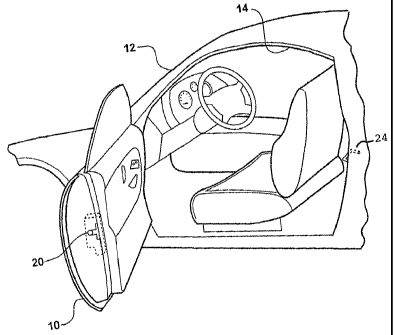Une partie des informations de ce site Web a été fournie par des sources externes. Le gouvernement du Canada n'assume aucune responsabilité concernant la précision, l'actualité ou la fiabilité des informations fournies par les sources externes. Les utilisateurs qui désirent employer cette information devraient consulter directement la source des informations. Le contenu fourni par les sources externes n'est pas assujetti aux exigences sur les langues officielles, la protection des renseignements personnels et l'accessibilité.
L'apparition de différences dans le texte et l'image des Revendications et de l'Abrégé dépend du moment auquel le document est publié. Les textes des Revendications et de l'Abrégé sont affichés :
| (12) Brevet: | (11) CA 2494674 |
|---|---|
| (54) Titre français: | LOQUET A INERTIE POUR VERROU DE VEHICULE |
| (54) Titre anglais: | INERTIA CATCH FOR A VEHICLE LATCH |
| Statut: | Réputé périmé |
| (51) Classification internationale des brevets (CIB): |
|
|---|---|
| (72) Inventeurs : |
|
| (73) Titulaires : |
|
| (71) Demandeurs : |
|
| (74) Agent: | |
| (74) Co-agent: | |
| (45) Délivré: | 2011-06-14 |
| (86) Date de dépôt PCT: | 2003-07-25 |
| (87) Mise à la disponibilité du public: | 2004-02-05 |
| Requête d'examen: | 2008-07-18 |
| Licence disponible: | S.O. |
| (25) Langue des documents déposés: | Anglais |
| Traité de coopération en matière de brevets (PCT): | Oui |
|---|---|
| (86) Numéro de la demande PCT: | PCT/CA2003/001167 |
| (87) Numéro de publication internationale PCT: | WO2004/011749 |
| (85) Entrée nationale: | 2005-01-26 |
| (30) Données de priorité de la demande: | ||||||
|---|---|---|---|---|---|---|
|
La présente invention concerne un mécanisme de verrouillage (20) permettant de verrouiller sélectivement une porte (10) sur un véhicule automobile. Ce mécanisme de verrouillage comprend un crochet (22) mobile entre des positions de blocage et de déblocage par rapport à une barre de butée (24) fixée de manière inamovible au véhicule. Un levier de libération (30) est couplé fonctionnellement entre le crochet du verrou (22) et le mécanisme de verrouillage pour permettre un actionnement sélectif dudit crochet de verrou entre les positions de blocage et de déblocage. Un levier à inertie (50) peut s'accoupler au levier de libération (30) pour empêcher le déplacement du crochet du verrou (22) entre les positions de déblocage et de blocage. Le levier à inertie (50) est couplé mobile au mécanisme de verrouillage de manière à se déplacer pour entrer en contact avec le levier de libération (30) ou s'éloigner de celui-ci en réponse à une accélération seuil du véhicule. Une fente (42) formée dans le levier de libération (30) présente des côtés (44, 46) pouvant s'accoupler avec le levier à inertie (50) pour basculer automatiquement le levier à inertie en réponse au déplacement du levier de libération (30) dans le but d'empêcher le grippage du levier à inertie à l'intérieur du mécanisme de verrouillage par manque d'utilisation.
A latch mechanism (20) for selectively latching a door (10) to an automotive
vehicle. The latch mechanism includes a latch hook (22) movable between locked
and unlocked positions relative to a striker bar (24) fixedly secured to the
vehicle. A release lever (30) is operatively coupled between the latch hook
(22) and the latch mechanism for selectively actuating the latch hook between
the locked and unlocked positions. An inertia lever (50) is engagable with the
release lever (30) to prevent movement of the latch hook (22) between the
unlocked and locked positions. The inertia lever (50) is movably coupled to
the latch mechanism for movement in and out of engagement with the release
lever (30) in response to a threshold acceleration of the vehicle. A slot (42)
is formed in the release lever (30) presenting sides (44, 46) engagable with
the inertia lever (50) to automatically rock the inertia lever in response to
movement of the release lever (30) to prevent seizing of the inertia lever
within the latch mechanism due to lack of use.
Note : Les revendications sont présentées dans la langue officielle dans laquelle elles ont été soumises.
Note : Les descriptions sont présentées dans la langue officielle dans laquelle elles ont été soumises.

Pour une meilleure compréhension de l'état de la demande ou brevet qui figure sur cette page, la rubrique Mise en garde , et les descriptions de Brevet , États administratifs , Taxes périodiques et Historique des paiements devraient être consultées.
| Titre | Date |
|---|---|
| Date de délivrance prévu | 2011-06-14 |
| (86) Date de dépôt PCT | 2003-07-25 |
| (87) Date de publication PCT | 2004-02-05 |
| (85) Entrée nationale | 2005-01-26 |
| Requête d'examen | 2008-07-18 |
| (45) Délivré | 2011-06-14 |
| Réputé périmé | 2017-07-25 |
Il n'y a pas d'historique d'abandonnement
Les titulaires actuels et antérieures au dossier sont affichés en ordre alphabétique.
| Titulaires actuels au dossier |
|---|
| INTIER AUTOMOTIVE CLOSURES INC. |
| Titulaires antérieures au dossier |
|---|
| PEREVERZEV, IGOR |